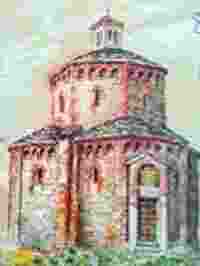Thinker

Saint Bonaventure is considered one of the major thinkers of the Franciscan tradition, which thanks to him began to become a real school of thought, both from a theological and philosophical point of view.
Bonaventura's scientific production is vast: it occupies ten large volumes (folio) in the monumental critical edition of the Friars of Ad Aquas Claras (Quaracchi - FI), 1882-1902.
Join Us
The works
Since Bonaventura's scientific production is very vast both in quantity and variety of topics, only a few titles are offered based on the nature of the content.
Bonaventura's work is certainly the work of a theologian and this is demonstrated by the first four volumes of Quaracchi's edition, which collect the commentary on the theological teaching manual of the 13th century, the Sentences of Pietro Lombardo. Bonaventure commented on them between 1250 and 1254.
Volumes VI and VII contain his commentaries on books of the Old Testament: commentary on the Book of Ecclesiastes, on the Gospel of John (vol. VI), the commentary on the Gospel of Saint Luke, written in 1248. We know that Bonaventure commented on the Song of Songs, the Apocalypse, the canonical epistles.
Volume V of Quaracchi's edition contains a set of works which, compared to the previous ones, could be called minor works, in the sense that their extension is shorter. The Breviloquium and the Itinerarium mentis in Deum have special characteristics. The first is a sum of theology. The history of salvation in which God is the Supreme Good. The Itinerarium is a note from a retreat held on Monte della Verna. The volume contains three series of Quaestiones disputetae. Three cycles of conferences. Five sermons, which become five theological-spiritual treatises.
Volume IX contains many of these sermons and can be read in the new edition of the Sunday Sermons, prepared by J.G. Bougerol.
Volume VIII is divided into two sections. The first contains spiritual writings or mystical works; the second, writings relating to the Franciscan order.
In the first section, the first booklet is the one entitled De triplici via. And a sum of spiritual theology dating back to the years 1259-1260. The text summarizes spiritual theology, articulating its development into three ways or paths to reach intimate union with God. The doctrine and system have become classics in spiritual theology.
The second is called Soliloquium de quattuor exercitiis; its date of composition can be set at 1257. It is a book of meditations that responds to the program of De triplici via, written in the form of a dialogue.
The third is the Lignum Vitae, a central meditation in the mystery of Christ. Written around 1260, it is a set of forty-eight meditations on the mysteries of the life of the Lord. The text, of an unsurpassed literary quality, as its pedagogical value is unsurpassed, divides the meditations into four flowers and each flower into four fruits, which facilitate memorization of the work.
The fourth of these writings is that of De quinque festivitatibus pueri Iesu. It is a spiritual meditation, which following the mysteries of Christ's infancy; virginal conception, birth, imposition of the name, adoration of the Magi.
The fifth pamphlet, Tractatus de praeparatione ad missam is a work whose Bonaventurian authenticity is not considered certain today. The manuscript tradition is very late. The language differs from that used in authentic writings.
The sixth pamphlet is the one called De perfectione vitae ad sorores, composed for Elizabeth of Longchamp, sister of Saint Louis, king of France. Eight chapters describe what religious life should be.
The seventh pamphlet, de regimene animae, perhaps composed for Queen Blanche of Navarre, is a very short treatise and the feeling of Deo altissime, piissime, sanctissime, where what the regime of the soul must be is articulated with the practice of humility, devotion, purity, pain of sins, desire for divine gifts.
The eighth pamphlet, de sex alis seraphim and the tenth Vitis mystica (1475-1482).
The ninth pamphlet, Officium de Passion Domini was composed between 1242 and 1248 at the request of Saint Louis of France, deals with the Passion and is a splendid mosaic of biblical texts.
 Saint Bonaventure is considered one of the major thinkers of the Franciscan tradition, which thanks to him began to become a real school of thought, both from a theological and philosophical point of view.
Saint Bonaventure is considered one of the major thinkers of the Franciscan tradition, which thanks to him began to become a real school of thought, both from a theological and philosophical point of view.